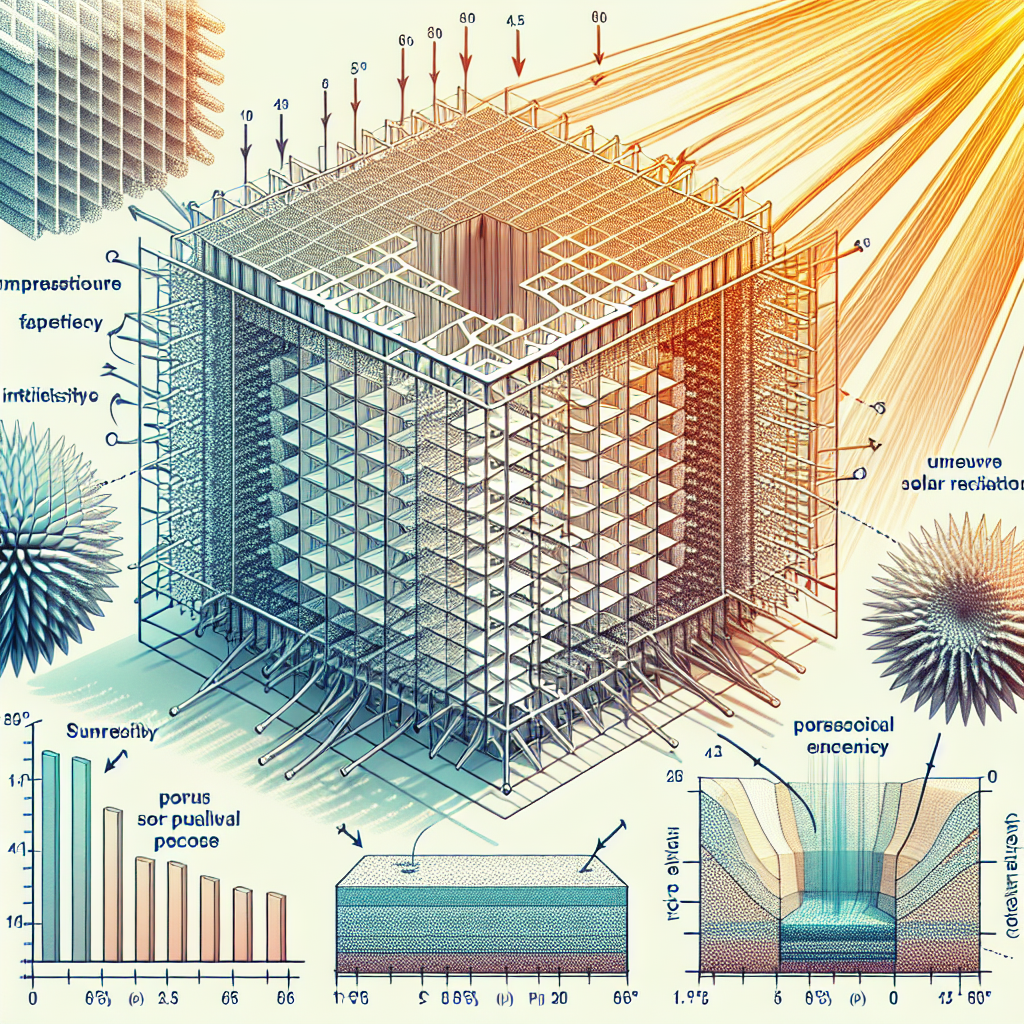-
Table of Contents
- Parametric Study of Empirical Factors and Solar Radiation Uniformity on Thermal Efficiency of Porous Volumetric Solar Receivers
- Introduction to Porous Volumetric Solar Receivers
- Historical Context
- Volume-Averaging Method: A Modeling Framework
- Advantages of VAM
- Empirical Parameters Influencing Thermal Efficiency
- Case Study: Sensitivity Analysis
- Solar Radiation Uniformity: A Critical Factor
- Impact of Non-Uniform Irradiation
- Optimization Strategies
- Material Selection
- Geometric Configuration
- Flux Management
- Experimental Validation
- Case Study: Plataforma Solar de Almería (PSA)
- Future Directions
Parametric Study of Empirical Factors and Solar Radiation Uniformity on Thermal Efficiency of Porous Volumetric Solar Receivers

As the global energy landscape shifts toward sustainable and renewable sources, solar thermal energy has emerged as a promising solution for high-temperature applications. Among the various solar receiver technologies, porous volumetric solar receivers (PVSRs) have garnered significant attention due to their superior thermal performance and potential for high solar-to-thermal conversion efficiency. This article delves into the parametric analysis of empirical factors and solar radiation uniformity on the thermal efficiency of PVSRs, drawing insights from the volume-averaging method and recent research published in Solar Energy Materials.
Introduction to Porous Volumetric Solar Receivers
Porous volumetric solar receivers are advanced components in concentrated solar power (CSP) systems. Unlike traditional surface receivers, PVSRs absorb solar radiation volumetrically within a porous medium, allowing for more uniform heat distribution and higher thermal efficiency. These receivers are typically composed of ceramic or metallic foams with high porosity and thermal conductivity, enabling them to withstand extreme temperatures while maintaining structural integrity.
Historical Context
The concept of volumetric solar receivers dates back to the 1980s, with early prototypes developed in Europe under the Solar Thermal Energy Program. Over the decades, advancements in materials science and computational modeling have significantly improved the design and performance of PVSRs. Today, they are integral to next-generation CSP systems, particularly in solar tower configurations where concentrated sunlight is directed onto a central receiver.
Volume-Averaging Method: A Modeling Framework
The volume-averaging method (VAM) is a powerful computational approach used to model heat and mass transfer in porous media. By averaging the governing equations over a representative elementary volume (REV), VAM simplifies the complex interactions within the porous structure while retaining essential physical characteristics. This method is particularly effective for analyzing PVSRs, where direct numerical simulation of every pore is computationally prohibitive.
Advantages of VAM
- Reduces computational cost while maintaining accuracy
- Captures macroscopic behavior of heat transfer and fluid flow
- Facilitates parametric studies and optimization
Empirical Parameters Influencing Thermal Efficiency
Accurate prediction of thermal performance in PVSRs hinges on the precise assessment of empirical parameters. These parameters, often derived from experimental data or semi-empirical correlations, include:
- Porosity (ε): The fraction of void space in the porous medium. Higher porosity generally enhances fluid flow but may reduce heat absorption.
- Permeability (K): A measure of the medium’s ability to allow fluid flow. It affects pressure drop and convective heat transfer.
- Thermal conductivity (k): Governs the conduction of heat through the solid matrix. Materials with high thermal conductivity improve heat distribution.
- Absorptivity (α): The ability of the material to absorb solar radiation. High absorptivity is crucial for efficient energy capture.
- Emissivity (ε): Influences radiative heat losses. Lower emissivity reduces energy loss to the surroundings.
Case Study: Sensitivity Analysis
A recent study published in Solar Energy Materials conducted a comprehensive sensitivity analysis using VAM to evaluate the impact of these empirical parameters on thermal efficiency. The results indicated that:
- Thermal conductivity and absorptivity had the most significant influence on peak temperature and efficiency.
- Porosity and permeability affected the pressure drop and flow distribution, indirectly impacting heat transfer.
- Emissivity played a critical role in determining radiative losses, especially at higher operating temperatures.
Solar Radiation Uniformity: A Critical Factor
Uniform distribution of solar radiation across the receiver surface is essential for optimal performance. Non-uniform irradiation can lead to localized overheating, thermal stresses, and reduced efficiency. The study explored various irradiation profiles, including Gaussian, top-hat, and cosine distributions, to assess their impact on thermal behavior.
Impact of Non-Uniform Irradiation
Non-uniform solar flux can cause:
- Hot spots that degrade material properties
- Inefficient utilization of the receiver volume
- Increased thermal gradients leading to mechanical failure
By integrating solar radiation models with VAM, researchers were able to simulate the thermal response of PVSRs under different irradiation conditions. The findings emphasized the need for advanced heliostat field design and real-time flux control to ensure uniform energy distribution.
Optimization Strategies
To enhance the thermal efficiency of PVSRs, several optimization strategies were proposed:
Material Selection
Choosing materials with high thermal conductivity and absorptivity while maintaining structural stability is crucial. Advanced ceramics and metal foams with tailored microstructures offer promising solutions.
Geometric Configuration
Optimizing the geometry of the porous medium, such as pore size and thickness, can improve heat transfer and reduce pressure drop. Computational tools like VAM enable rapid prototyping and testing of different configurations.
Flux Management
Implementing flux homogenizers or secondary concentrators can mitigate non-uniform irradiation. Additionally, adaptive control systems that adjust heliostat angles in real-time can maintain consistent flux distribution.
Experimental Validation
While computational models provide valuable insights, experimental validation is essential for verifying theoretical predictions. Several pilot-scale experiments have been conducted to test PVSRs under controlled conditions. These studies confirmed the accuracy of VAM-based simulations and highlighted the importance of empirical parameter calibration.
Case Study: Plataforma Solar de Almería (PSA)
At the PSA in Spain, researchers tested a ceramic PVSR under varying solar flux conditions. The experimental data closely matched the VAM predictions, with thermal efficiencies exceeding 85% under optimal conditions. This validation underscores the reliability of the modeling approach and its applicability to real-world systems.
Future Directions
As CSP technology continues to evolve, future research will focus on:
- Developing smart materials with tunable thermal properties
- Integr
